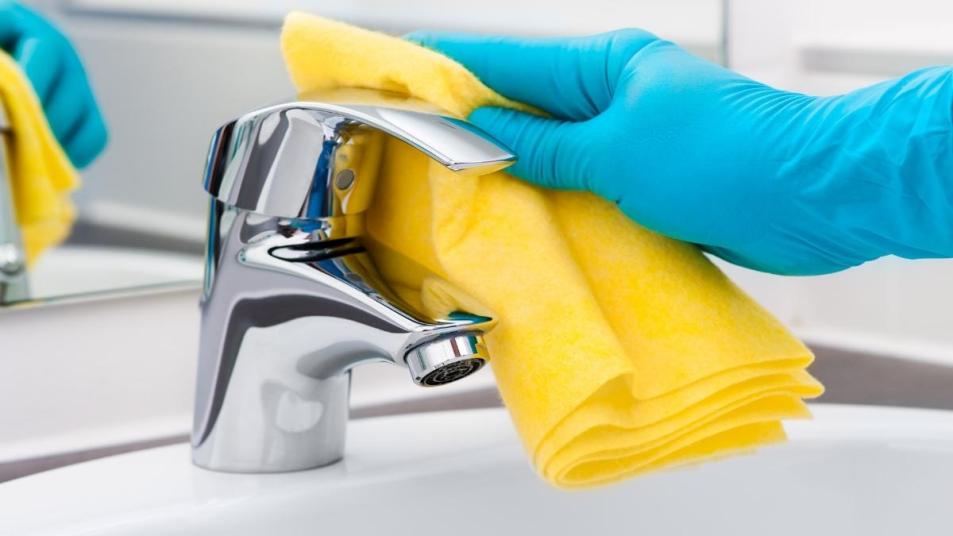How To Clean Faucet Head Buildup + 3 Reasons Why You Don’t Want To Wait
Limescale can eat into the finish, turn into mold and even start clogging your pipes, caution pro cleaners

When it comes to the list of things you normally tackle when cleaning your bathroom or your kitchen, your faucet head can be easy to miss in lieu of more glaring messes like someone’s hair all over the shower door or a dirty drain. Sure you may give the faucet a quick swipe when washing the inside of the sink or bathtub, but if you notice any faucet head buildup, you’ll want to take it seriously. Not only does it get harder to remove the longer it sits, but it can actually lead to more dire consequences like burst pipes. That’s why we asked cleaning pros how to clean faucet head buildup with little effort so it doesn’t feel like we’re adding yet another task to the list.
What is the gunk on my faucet head?

The gunk on your faucet head is usually limescale, a hard, chalky deposit, composed mainly of calcium carbonate that often builds up inside kettles, boilers, and pipework. “The most common cause of limescale buildup is having hard water, which mostly affects people who get their water supply from a well,” says Elizabeth Devilbiss, Cleaning Technician at Dirt Detective Cleaning. Abby Stephens, Cleaning Professional at BritLin Cleaning, adds that “as the water runs through the faucet and then dries, any limestone deposits within the water gets left on the surfaces.” (Click through to learn how to remove hard water stains from glass.)
“The second cause of buildup is splashback residue from soaps and shampoos,” Devilbiss continues. “Just like they cause buildup in your showers and tubs, they cause buildup on your faucets.”
Of course the chalky white substance can look just plain gross, but there’s also a couple functional reasons for taking care of it. One, If it sits there long enough, it can turn into unhealthy-for-you mildew and mold. And two, according to Devilbiss, the buildup — which can post up in the pipes too — can lead to water flow issues. If you wait too long to address it, you’ll end up with clogged pipes (sometimes to the point of being permanently unusable) or even burst pipes. Finally, limescale can eat away at the finish of your faucet over time, permanently ‘staining’ it.
How to clean faucet head buildup: sink
For overall cleaning, Stephens starts by scrubbing the faucet head buildup with a wet towel soaked in a neutral pH product. “If needed, I’ll use a toothbrush to scrub any scum or grime in the nooks and crannies,” she continues. She then uses a cleaning product based on the kind of buildup on the faucet (see below for specifics), then finishes with the wipe of a wet towel.
To clean limescale and hard water buildup
“You can use a little bit of an acidic cleaner to remove hard water since it will eat through the grime,” says Stephens. She likes Lime A-Way, (Buy on Amazon, $6.68). Simply spray it on the faucet head and, “let it sit for the recommended amount of time, then scrub with a non-scratch pad.” (Click through for more ways to remove limescale.)
To clean black mold buildup
If the spots are mold (which they usually are), then Stephens uses a bleach-based product such as Tilex (Buy on Amazon, $19.99 for a pack of two 32 oz. bottles), to kill the spores before scrubbing and rinsing them away. This works for black mold seen along the faucet and a faucet hose hose as well. (Click through to discover why you shouldn’t mix bleach and baking soda when trying to eradicate mold.)
This YouTube video shows how to clean black mold from the faucet head and the sink drain with a bleach-infused spray:
How to clean faucet head buildup: shower head
To clean a hard-to-reach or larger faucet head, the pros all agree on the bag method. This starts with a strong, hole-free plastic bag — Devilbiss recommends a gallon-size Ziploc freezer bag. This is how she gets the job done using a mix of vinegar and baking soda which together create a fizz that helps break down gunk, limescale and mold buildup.
- Fill the bag with ⅓ cup of baking soda for every 1 cup of vinegar until the head is completely submerged.
- Secure the bag around the head with a zip tie or heavy-duty rubber band, making sure it won’t fall.
- Let the head soak for at least 90 minutes, though tougher buildup may need to soak overnight.
- Remove the bag and check for residual buildup, scrubbing with a toothbrush if necessary.
- Run hot water for 3 to 5 minutes to rinse away any remaining vinegar solution.
How often should I clean my faucet head?
In an ideal world, you should be cleaning faucets about once a week, or as often as you clean the rest of the bathroom. “If you catch it early, you may not need to soak it in vinegar and instead can just scrub it with a toothbrush, then rinse and dry,” explains Stephens. “The key to keeping hard water and limescale at bay is to dry faucets after each use.”
At minimum, Devilbiss says you should be cleaning the faucet head monthly to keep buildup at bay and reduce water flow issues. If buildup is a consistent problem for you, it’s also recommended that you install and maintain a water softener.
For more sink cleaning hacks, click through the links below:
The Best Way To Clean a Stainless Steel Sink? Plain Old Flour, Says Cleaning Pro
The Best Way To Clean Your Garbage Disposal To Get Rid of Grease, Smell & Clogs
















